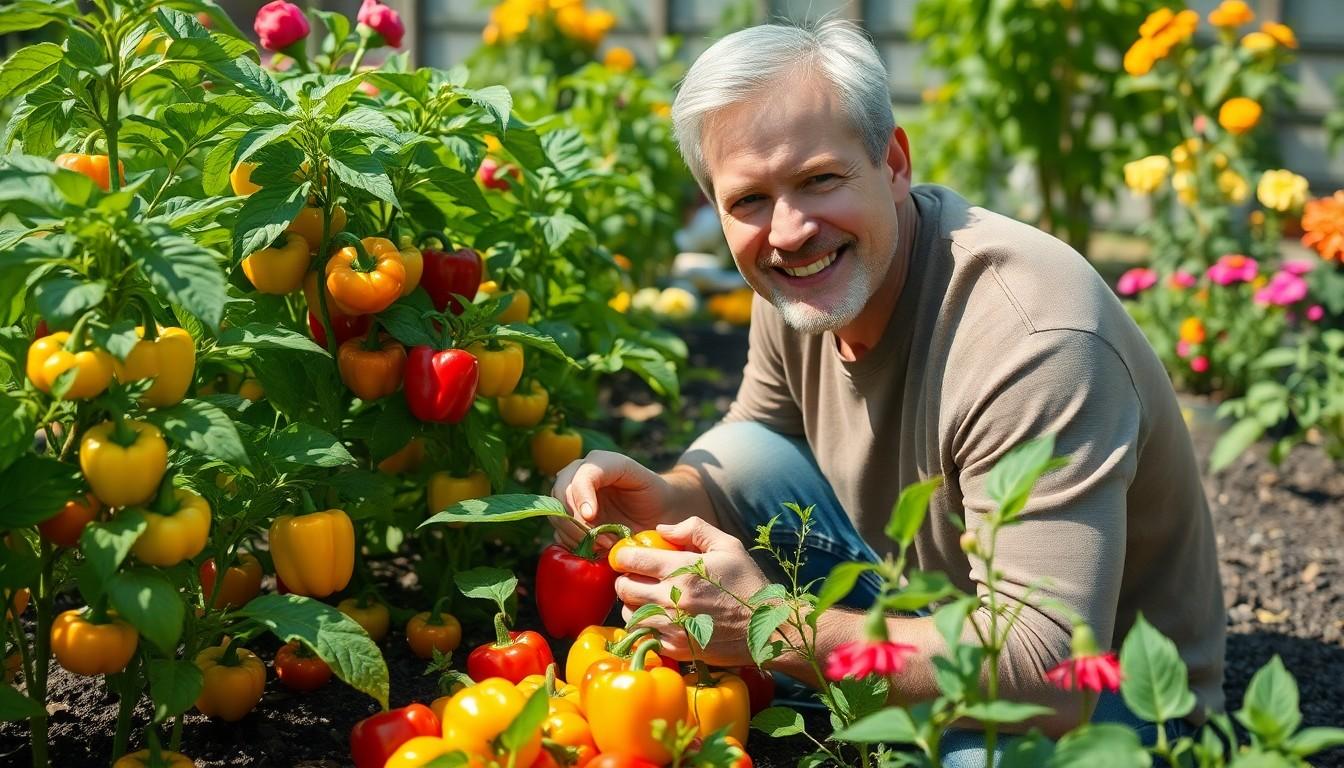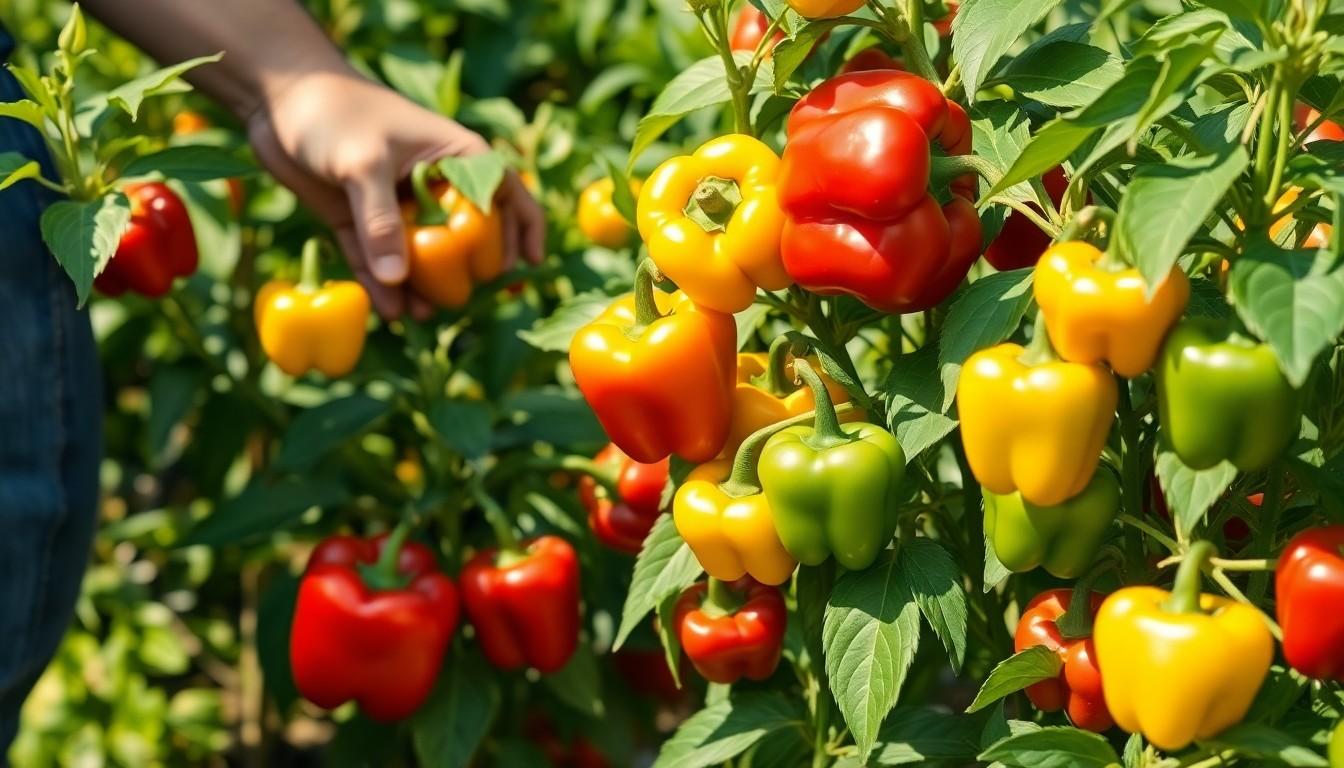The Best Fluffy Pancakes recipe you will fall in love with. Full of tips and tricks to help you make the best pancakes.

Bell Pepper Gardening Tips: Unlock Your Backyard’s Hidden Harvest Potential
If you think bell peppers are just colorful additions to your salad, think again! These vibrant veggies can turn any garden into a culinary wonderland. With a little know-how, anyone can grow a bountiful crop that’ll make friends green with envy. Imagine plucking fresh, juicy peppers right from your backyard, ready to spice up your favorite dishes.
Bell Pepper Gardening Tips
Choose the right variety of bell pepper to grow based on climate and culinary needs. Popular options include California Wonder, Bell Boy, and Golden Bell. Each variety has distinct flavors and colors.
Start seeds indoors about 8 to 10 weeks before the last frost date. This practice enhances germination rates and ensures healthy seedlings. Transplant seedlings outdoors once the danger of frost passes, typically when soil temperatures reach 65°F.
Plant bell peppers in a sunny location. Six to eight hours of direct sunlight boosts growth and fruit production. Soil should be well-draining and rich in organic matter. Adding compost improves soil quality and provides essential nutrients.
Water consistently but avoid over-watering. Bell peppers thrive with about one inch of water per week. Early morning is the best time for watering to reduce evaporation and disease risk.
Fertilize with a balanced fertilizer every four to six weeks. Such fertilizers promote healthy foliage and strong fruit development. Look for options labeled specifically for vegetables or peppers.
Mulch around plants to retain moisture and suppress weeds. Use organic materials like straw or wood chips for effective results. This practice helps regulate soil temperature.
Monitor plants for pests and diseases regularly. Common pests include aphids and spider mites while diseases may include blossom end rot. Early detection allows for prompt action and protects the harvest.
Provide support for taller varieties. Staking or caging plants prevents fruit damage and promotes better air circulation. Healthy airflow reduces moisture buildup, minimizing disease potential.
Choosing the Right Variety

Choosing the right bell pepper variety significantly impacts the growing experience and the harvest’s quality. Selecting varieties based on climate and culinary preferences ensures successful gardening.
Popular Bell Pepper Varieties
California Wonder is a classic choice, known for its large, sweet fruits that mature to a vibrant red. Bell Boy features sturdy, productive plants with thick walls and excellent flavor. Golden Bell provides a unique option with its yellow fruits, offering a slightly sweeter taste ideal for various dishes. These varieties suit different gardens, each bringing distinct characteristics and benefits.
Factors to Consider
Climate conditions play a crucial role in variety selection. Heat-loving varieties thrive in warmer regions, while cooler climates favor more resilient options. Taste preferences determine whether to choose sweet varieties or those with a bit of heat. Growth habits matter too, as some varieties are compact, making them suitable for smaller spaces. Lastly, disease resistance contributes significantly to overall plant health and productivity, so selecting resistant varieties generally results in better yields.
Preparing the Soil
Preparing the soil properly sets the foundation for healthy bell pepper plants. Focus on achieving the right balance of nutrients and drainage for optimal growth.
Soil Composition
Soil composition plays a crucial role in bell pepper development. Choose loamy soil, as it contains a mixture of sand, silt, and clay, allowing for both drainage and retention. Incorporating organic matter, such as compost or well-rotted manure, enriches the soil with vital nutrients. Consider including peat moss, which enhances moisture retention. Aim for a soil depth of at least 12 inches to support root expansion. Drainage is essential; ensure the soil does not remain waterlogged.
pH Levels
pH levels significantly affect nutrient availability for bell peppers. Aim for a pH range of 6.0 to 6.8, which optimizes nutrient absorption. Conduct a soil test to determine current pH levels accurately. If the soil is too acidic, add lime to raise the pH. Conversely, sulfur can lower pH if the soil is too alkaline. Regularly monitoring pH levels encourages consistent growth and helps achieve a bountiful harvest of bell peppers.
Planting Your Bell Peppers
Planting bell peppers involves specific timing and careful attention to spacing and depth to encourage healthy growth and bountiful harvests.
Optimal Planting Time
Transplant bell pepper seedlings outdoors only after the danger of frost has passed. The ideal target for planting occurs about 2 weeks after the last expected frost date in the area. Bell peppers thrive under warmer conditions, so soil temperatures should reach at least 65°F. Starting seedlings indoors 8 to 10 weeks before this date allows for stronger plants. They adapt well to both warm soil and air temperatures, making mid-spring optimal for planting.
Spacing and Depth
Proper spacing and depth support healthy bell pepper growth. Seedlings should be planted 18 to 24 inches apart to allow for adequate air circulation and sunlight exposure. Rows need to be spaced 24 to 36 inches apart to facilitate easy movement and care. When planting, ensure that the root ball is at soil level, with about ½ inch of space above the root ball to prevent rot. This depth promotes strong root systems, crucial for nutrient absorption and stability.
Caring for Your Bell Peppers
Caring for bell peppers involves a few key practices that ensure a thriving garden full of delicious fruits.
Watering Techniques
Consistent watering plays a crucial role in bell pepper health. One inch of water each week suffices, with early morning being the best time for application. Deep watering encourages root development, making plants stronger. Consider using drip irrigation or soaker hoses for efficient moisture delivery. Monitoring soil moisture helps gauge when to water; checking the top inch can reveal dryness. Adjust frequency during heatwaves, as peppers may need additional hydration during these times.
Fertilization Tips
Fertilizing every four to six weeks helps promote vibrant growth. A balanced fertilizer, such as a 10-10-10 ratio, works effectively. Incorporating organic compost enriches the soil with nutrients and improves structure. Prioritize adjustments based on soil tests to tailor nutrient input according to specific deficiencies. Side-dressing with organic matter at mid-season boosts plant vigor and fruit quality. Following the manufacturer’s recommendations ensures proper usage and benefits.
Pest and Disease Management
Vigilance in pest and disease management keeps bell peppers healthy. Regular inspections for aphids, spider mites, and whiteflies enable early detection, allowing intervention before infestations escalate. Surrounding plants with beneficial insects, such as ladybugs, naturally controls harmful populations. Using neem oil or insecticidal soap provides organic control options for managing pests effectively. Crop rotation and resistant varieties help combat diseases like bacterial leaf spot and powdery mildew. Maintaining good air circulation around plants mitigates disease risks and fosters better health.
Harvesting Bell Peppers
Harvesting bell peppers requires attention to signs of ripeness and adherence to best practices. Knowing when to harvest ensures optimal flavor and quality.
Signs of Ripeness
Look for glossy skin, which indicates maturity in bell peppers. Colors vary by variety; however, red, yellow, and orange typically signal ripeness. Measure fruit size, aiming for 3 to 4 inches in length for most types. Observe the firmness; ripe peppers feel solid when gently squeezed. Taste an early sample if uncertain; ripe peppers offer a sweet, mild flavor. Notice the stem, which may start to turn brown as peppers ripen. Check the days after transplanting; most varieties harvest between 60 to 90 days post-planting.
Best Practices for Harvesting
Use sharp garden shears or scissors to prevent damage during harvesting. Cut the stem above the calyx instead of pulling the fruit, which protects the plant. Harvest in the morning when temperatures are cooler to maintain freshness. Collect peppers frequently; this stimulates further production. Wear gloves to avoid contact with the skin’s oils from fresh peppers, especially those with a higher heat level. Store harvested peppers in a cool, dry place to extend shelf life. Keep peppers intact for a longer duration by avoiding exposure to moisture.
Transform Any Garden Into A Vibrant And Productive Space
Growing bell peppers can transform any garden into a vibrant and productive space. With the right techniques and care, anyone can enjoy the fruits of their labor. It’s not just about planting seeds; it’s about understanding the needs of these colorful vegetables to ensure a successful harvest.
By selecting the appropriate varieties and providing optimal growing conditions, gardeners can cultivate healthy plants that yield delicious peppers. Regular maintenance and monitoring for pests will further enhance the gardening experience. Embracing these tips will lead to the joy of harvesting fresh bell peppers, adding flavor and nutrition to meals straight from the garden.
